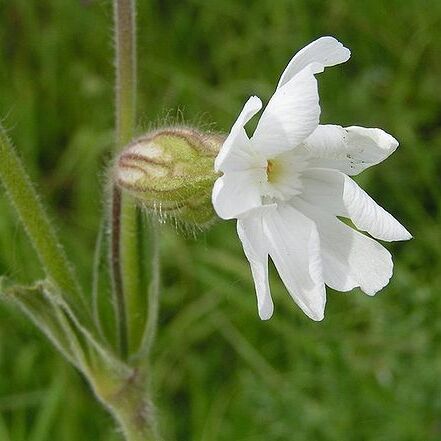Herbs annual, biennial, or perennial, rarely plants suffrutescent. Stems erect, ascending, or creeping. Leaves subulate, linear or lanceolate to ovate-lanceolate, or elliptic. Flowers bisexual or unisexual; male-sterile flowers frequent in otherwise hermaphroditic plants. Male-sterile flowers often have markedly shorter androgynophores and petal limbs than hermaphroditic flowers. Inflorescence a monochasium, dichasium, thyrse or flower solitary. Calyx tubular, funnel-shaped, campanulate, or ovoid, usually 10-veined, with 5 teeth with ciliate membranous margin; the form of this margin usually varies between teeth in a single calyx. Petals 5, each with a sometimes auriculate claw; limb entire, bifid, 4-fid, or laciniate, variously colored; coronal scales present. Androgynophore ± conspicuous. Stamens 10. Ovary usually with 3 or 5 basal septa; ovules numerous; styles 3 or 5. The protrusion of stamens and styles from calyx mouth are correlated in perfect flowers. Fruit usually a capsule dehiscing with 6 or 10, rarely 5, teeth. Seeds reniform, minute, ± tuberculate, sometimes with abaxial spinose processes or a marginal wing.
Annual, biennial or perennial herbs. Hairs eglandular and/or glandular or 0. Lvs opposite, exstipulate, linear to ovate to obovate or oblanceolate. Infl. a compact to lax regular or irregular dichasium or raceme-like monochasium or a panicle with a central axis bearing lateral dichasia; bracts leaflike or scarious; epicalyx 0. Fls ☿ or unisexual. Calyx cylindric, ovoid or inflated, 10-, 20-or 30-veined, 5-toothed; commissures veined, not scarious. Petals 5, white to red, clawed; claw often lobed near base of limb; limb entire, emarginate or divided, sometimes 4-lobed; coronal scales variously shaped, paired at base of limb. Stamens 10. Styles 3 or (4)-5-(6 or more). Fr. an ovoid or cylindric capsule dehiscing by twice as many teeth as the styles, or by as many 2-fid teeth; carpophore very short to long. Seeds reniform, warty or ridged; faces flat or hollowed; backs flat or grooved, rarely winged.
Herbs, annual or perennial, rarely (not in Australia) dwarf shrubs, glabrous to hairy, often viscid. Leaves opposite, linear to obovate, oblong-lanceolate or spathulate; bracts herbaceous to subscarious. Flowers usually in terminal cymes, or solitary, sometimes in dense, cymose heads or spikes, 5-merous, unisexual or bisexual. Epicalyx absent. Calyx tubular, 10–30-veined, neither winged nor scarious between veins, 5-lobed. Petals 5, white, pink, purple or red, emarginate to 4-fid, usually exceeding calyx; coronal scales present or absent. Stamens 10. Ovary 1-celled, but often basally 3–5-celled; styles 3–5 with bases sometimes persistent in fruit. Capsule subglobose to narrowly ovoid or ovoid, opening by (3) 5–10 teeth; carpophore very short to as long as capsule. Seeds numerous, subdiscoid to ±reniform, tuberculate to finely striate-rugulose.
Annual, biennial or perennial herbs, rarely dwarfshrubs. Stems usually erect, glabrous or hairy, sometimes viscid. Leaves exstipulate, simple, opposite, not or only slightly connate at the base. Inflorescence cymose, few-or many-flowered, dense or lax, simple or compound. Epicalyx absent. Flowers 5-merous, mostly bisexual, sometimes unisexual. Calyx mostly consisting of 5 connate sepals, ± tubular, to spherical, dilated or inflated, 10-20-, 30-, or 60-nerved. Petals 5, long-clawed, with or without coronal scales, lamina entire, emarginate or bifid. Stamens 10, rarely reduced in number in female or bisexual flowers. Ovary 3-5-partite in lower part, in upper part unilocular; styles filiform, usually 3 (rarely 4 or 5). Capsule dehiscing by 3-6 teeth; carpophore present. Seeds numerous, reniform to spherical, sometimes with a dorsal wing.
Fls perfect or sometimes unisexual; cal-tube (5–)10–30-veined, with 5 short teeth, variously hairy or glandular or glabrous, sometimes inflated; pet 5, the claw narrow, usually expanded above into evident auricles at the juncture with the blade, and usually with a pair of appendages on the inner surface at the juncture; stamens 10, styles 3, less often 4 or 5, rarely more; ovary usually stipitate, the stamens and pet often adnate to the stipe; capsule unilocular or more or less completely plurilocular, dehiscent by twice as many teeth as the number of styles, or less often by only as many teeth as styles; seeds reniform to globose, roughened; annual to perennial herbs with opposite (seldom whorled), entire, exstipulate lvs. 400, mostly N. Temp.
Herbs or subshrubs. Leaves exstipulate, not or only very slightly connate at the base. Inflorescences cymose, panicled, spicate, aggregated-capitulate or reduced even to a solitary flower; no calycine bracts. Calyx tubular or dilated, 5 teeth, 10 main veins. Petals 5, with a long narrow claw and an entire or usually a bilobed limb. Stamens 5 + 5 in male or hermaphrodite flowers or abnormally reduced in number. Ovary 3-to 5-locular at least in the lower part though usually unilocular in the upper part; styles 2 to 5 but generally 3, filiform. Capsules dehiscing generally by 3 or 6 teeth or valves.
Petals 5, with a long narrow claw and a dilated, bifid or rarely simple or laciniate lamina, often with scales at the base of the limb.
Ovary 3–5-locular below but usually 1-locular in the upper part or 1-locular throughout, multiovulate; styles (2) 3 (5), filiform.
Flowers in cymose, paniculate, spicate or aggregate-capitulate inflorescences, or rarely single, unisexual or bisexual.
Capsule many-seeded, opening from the apex by 3 or 6 teeth or valves.
Leaves opposite, sometimes slightly connate at the base, exstipulate.
Stamens 5 + 5 in male or bisexual flowers or abnormally reduced.
Calyx tubular or dilated, 5-toothed, with 10 principal veins.
Seeds numerous, reniform or subspherical, sometimes winged.
Herbs or shrublets.

